Lentils are rich in plant protein, fiber, and essential nutrients that may help support heart health, digestion, and balanced blood sugar.
Understanding the benefits of lentils is vital for anyone aiming to improve overall wellness through nutrient-dense, affordable plant-based foods. These tiny legumes are a nutritional powerhouse — versatile, sustainable, and deeply researched for their role in supporting long-term health.
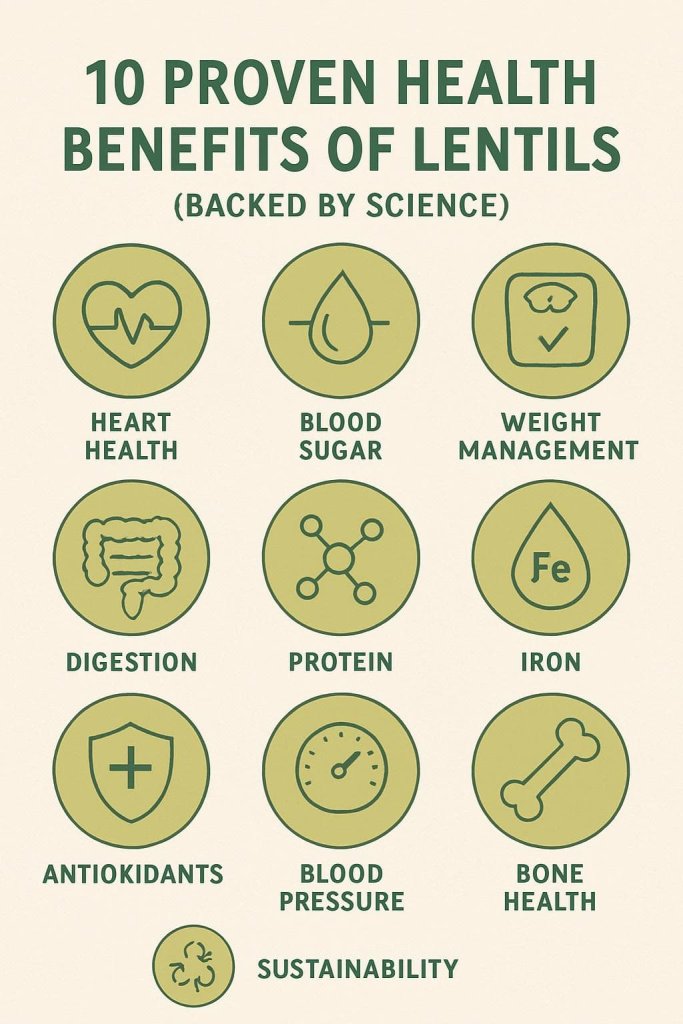
What Are Lentils? (and Nutritional Profile)
Lentils (Lens culinaris) are edible seeds from the legume family, commonly used in soups, stews, and salads around the world. They come in several varieties — brown, green, red, black (beluga), and French (puy) lentils — each offering unique flavor and texture.
Lentils are a staple source of plant-based protein and fiber, making them an excellent option for vegetarians, vegans, and anyone seeking a heart-healthy, nutrient-dense diet.
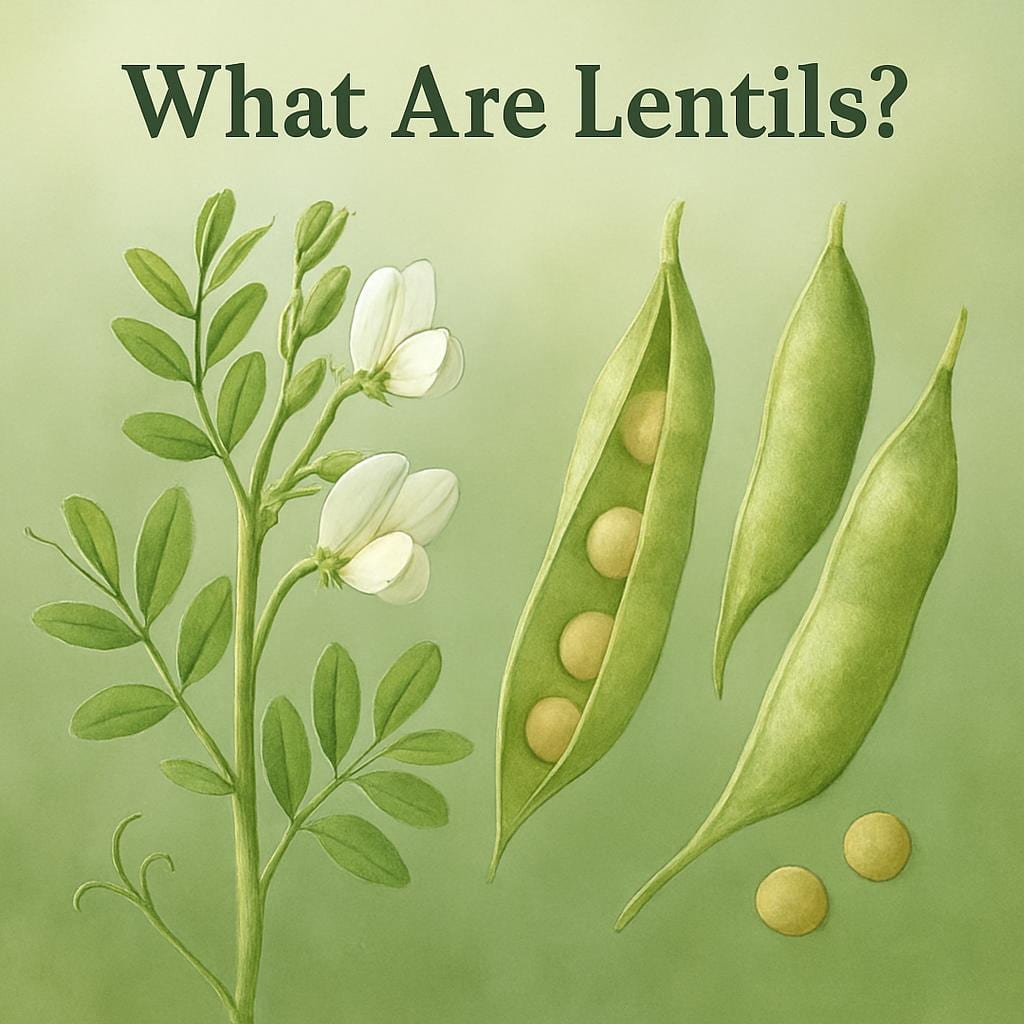
Nutritional Profile of Lentils
According to the USDA FoodData Central (2024), one cup (198 g) of cooked lentils provides:
| Nutrient | Amount | % Daily Value* |
|---|---|---|
| Calories | 230 kcal | — |
| Protein | 17.9 g | 36 % |
| Fiber | 15.6 g | 56 % |
| Total Fat | 0.8 g | 1 % |
| Carbohydrates | 39.9 g | 13 % |
| Folate | 358 µg | 90 % |
| Iron | 6.6 mg | 37 % |
| Potassium | 731 mg | 16 % |
| Magnesium | 71 mg | 18 % |
| Zinc | 2.5 mg | 23 % |
*Source: USDA FoodData Central, 2024
Lentils are naturally gluten-free, low in fat, and rich in polyphenols — bioactive compounds with antioxidant and anti-inflammatory potential.
10 Proven Health Benefits of Lentils (Backed by Science)
Lentils are nutrient-dense legumes that offer a wide range of wellness benefits — from supporting cardiovascular and digestive health to promoting stable energy and sustainable nutrition.
Below are ten evidence-based health benefits of lentils, supported by recent scientific and institutional research.
1. Supports Heart Health

Lentils may help support cardiovascular health by improving cholesterol and blood pressure levels.
According to a 2024 study published in Nutrients (MDPI), regular lentil consumption was associated with reduced low-density lipoprotein (LDL) cholesterol and lower inflammatory markers, including IL-17 and IL-1β.
This heart-protective effect is largely due to lentils’ high soluble fiber, which binds cholesterol in the digestive tract and helps remove it from the body. Additionally, minerals like potassium and magnesium support blood vessel relaxation and healthy blood pressure regulation.
The Cleveland Clinic also notes that diets rich in legumes, including lentils, are linked to lower cardiovascular disease risk and better lipid profiles.
2. Promotes Stable Blood Sugar Levels
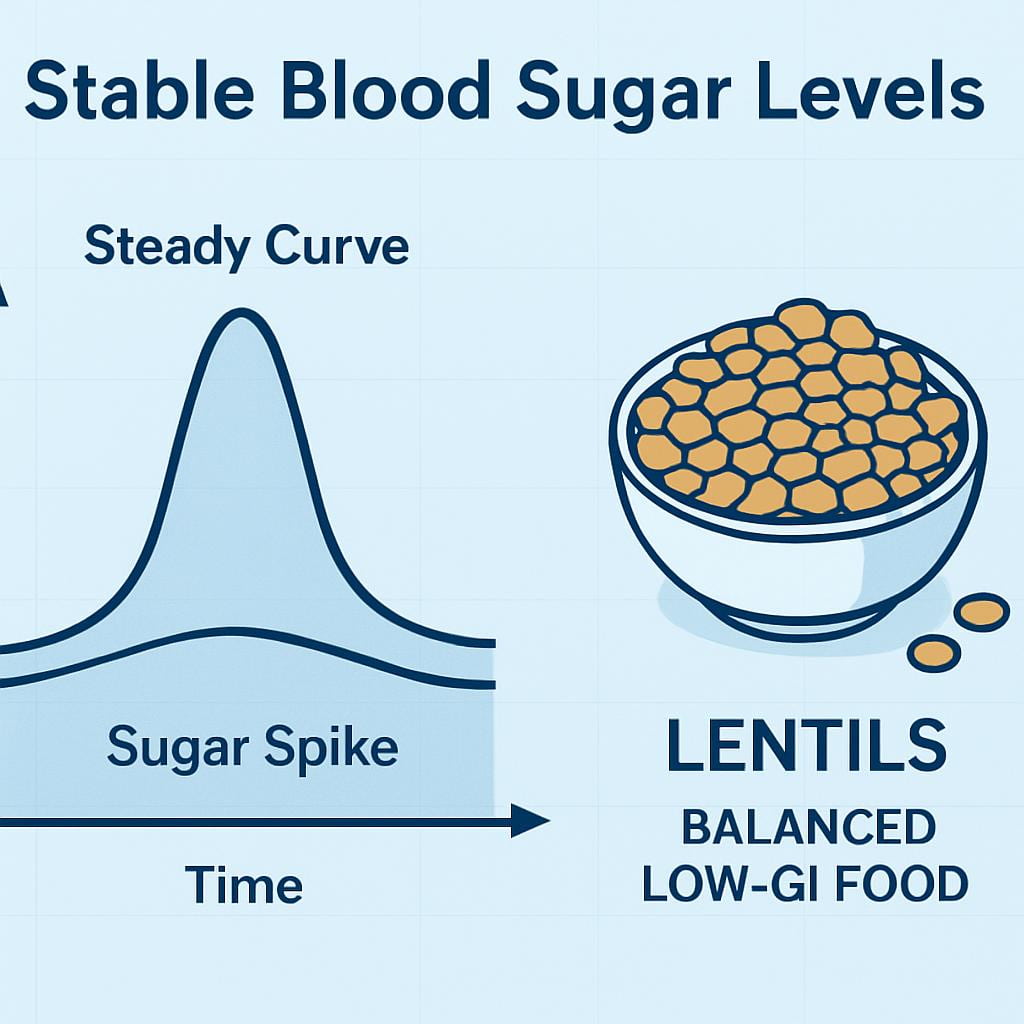
Lentils have a low glycemic index (GI), meaning they release glucose slowly into the bloodstream, helping maintain steady energy and prevent sugar spikes.
Their combination of complex carbohydrates, fiber, and resistant starch supports insulin sensitivity and may reduce the risk of type 2 diabetes.
The Harvard T.H. Chan School of Public Health highlights lentils as a smart carbohydrate choice for glycemic control, noting that replacing refined grains with lentils can improve long-term blood sugar balance.
Including lentils in meals with vegetables and healthy fats enhances these effects even further.
3. May Aid in Weight Management

Lentils are naturally low in fat but high in protein and fiber, two nutrients that increase satiety and reduce hunger between meals.
A systematic review in Obesity Reviews (2023) found that diets incorporating legumes such as lentils are associated with improved weight management and lower body-mass index (BMI) in adults.
Their slow-digesting carbohydrates and balanced macronutrient profile may help regulate appetite and support sustainable weight loss when combined with a healthy diet and physical activity.
4. Supports Digestive and Gut Health
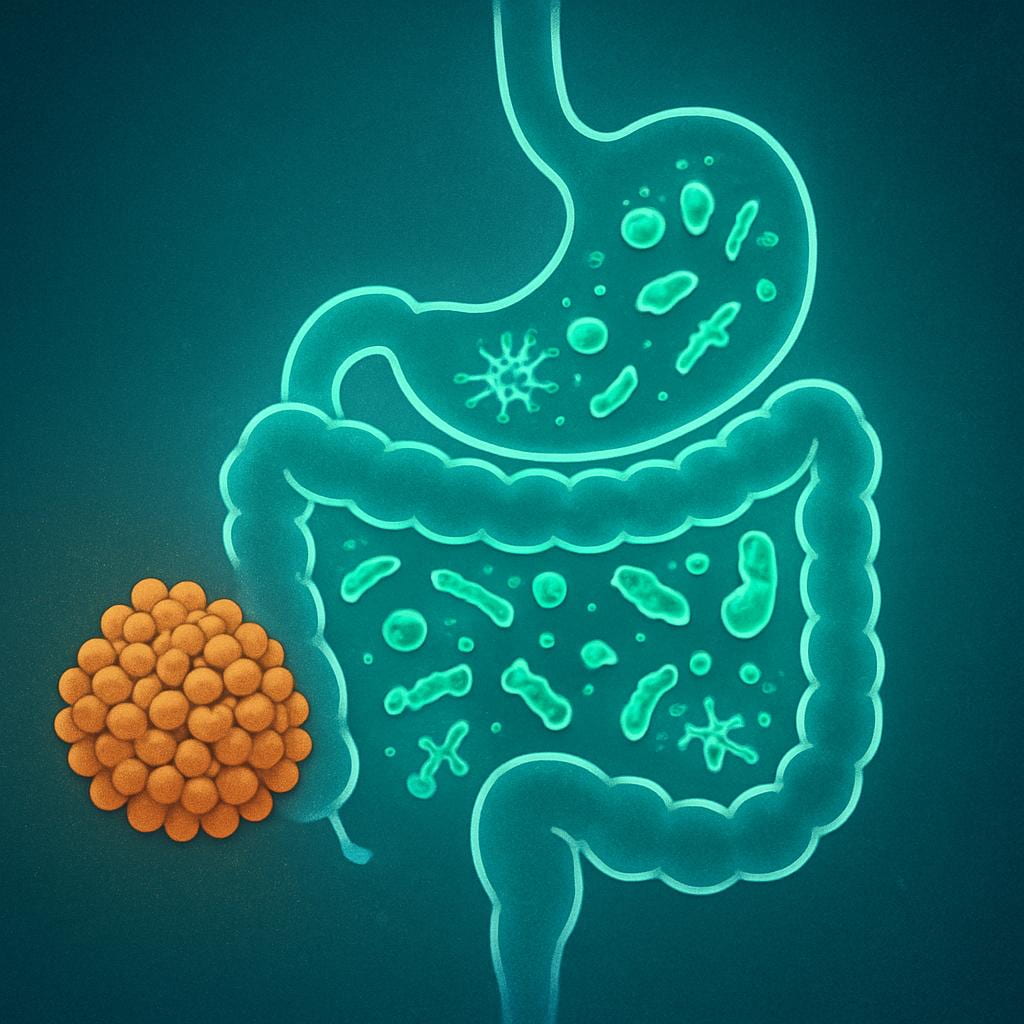
Lentils are excellent for digestive wellness because they provide both soluble and insoluble fiber, which support gut motility and nourish beneficial gut bacteria.
Research published in Frontiers in Nutrition (2023) shows that regular consumption of legumes like lentils increases gut microbiome diversity and promotes short-chain fatty acid (SCFA) production — essential for colon health.
A balanced gut microbiome contributes to better digestion, immune support, and overall metabolic well-being.
5. Rich Source of Plant Protein

One cup of cooked lentils provides roughly 18 grams of protein, making them one of the best plant-based protein sources available.
For vegetarians and vegans, lentils are a foundational protein source that supports muscle maintenance, tissue repair, and energy metabolism.
While lentils are not a complete protein on their own, combining them with whole grains (like rice, quinoa, or barley) ensures all nine essential amino acids — ideal for balanced plant-based nutrition.
The U.S. Department of Agriculture (USDA) lists lentils among top protein-dense plant foods that also supply iron and zinc.
6. Supports Iron and Folate Intake
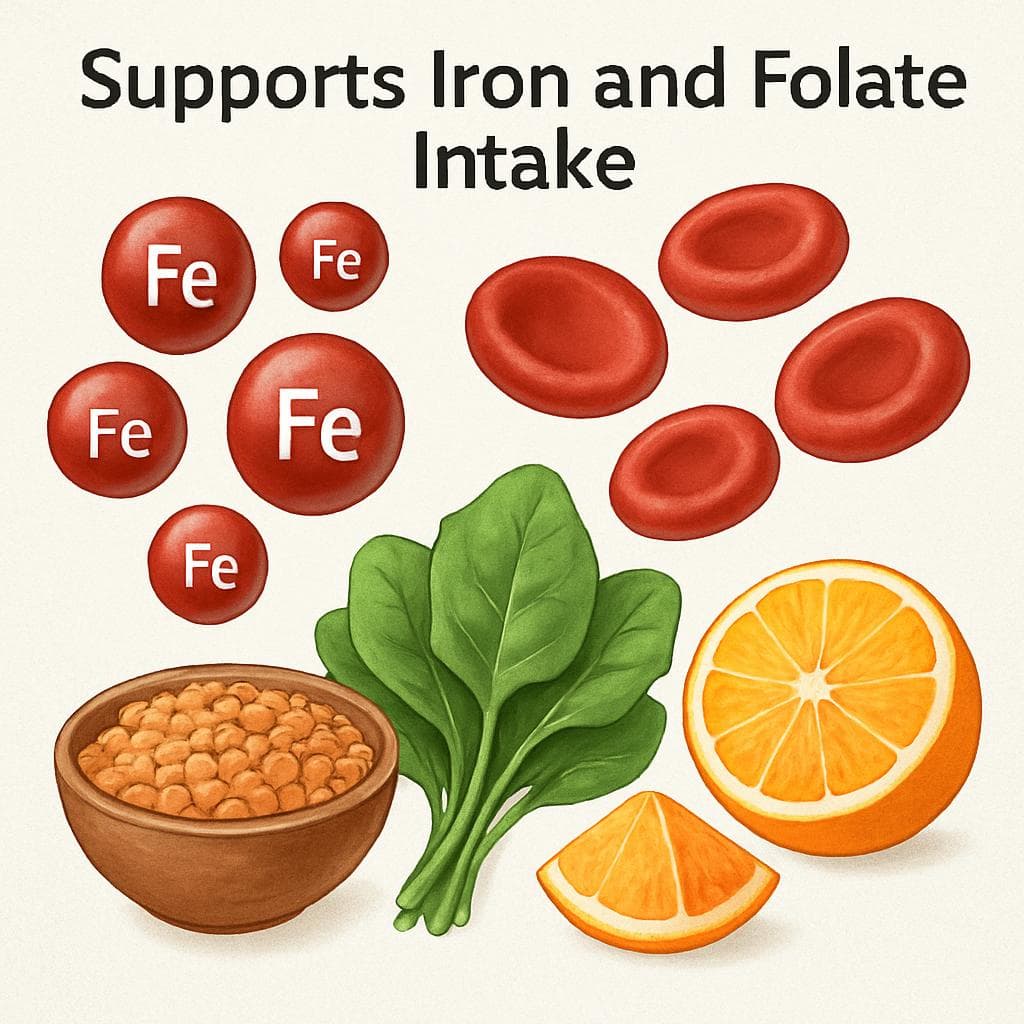
Lentils are among the richest plant sources of iron and folate, key nutrients for red blood cell formation and energy production.
Just one cup provides nearly 90% of the daily folate requirement, crucial for DNA synthesis and fetal development during pregnancy.
According to the National Institutes of Health Office of Dietary Supplements (NIH ODS), folate deficiency increases the risk of neural tube defects, making lentils a valuable addition to prenatal diets.
Meanwhile, lentil iron contributes to reducing the likelihood of fatigue and anemia in plant-based eaters. Pairing lentils with vitamin C-rich foods (like tomatoes or citrus) enhances non-heme iron absorption.
7. Provides Antioxidant and Anti-Inflammatory Compounds

Lentils contain powerful polyphenols such as tannins, flavonoids, and phenolic acids, which may help neutralize free radicals and reduce inflammation.
A review in Molecules (2022) highlighted lentil polyphenols’ potential roles in metabolic, cardiovascular, and neuroprotective support.
These compounds may contribute to oxidative balance and healthy aging, reinforcing lentils’ place as a functional food in preventive nutrition.
8. May Support Healthy Blood Pressure
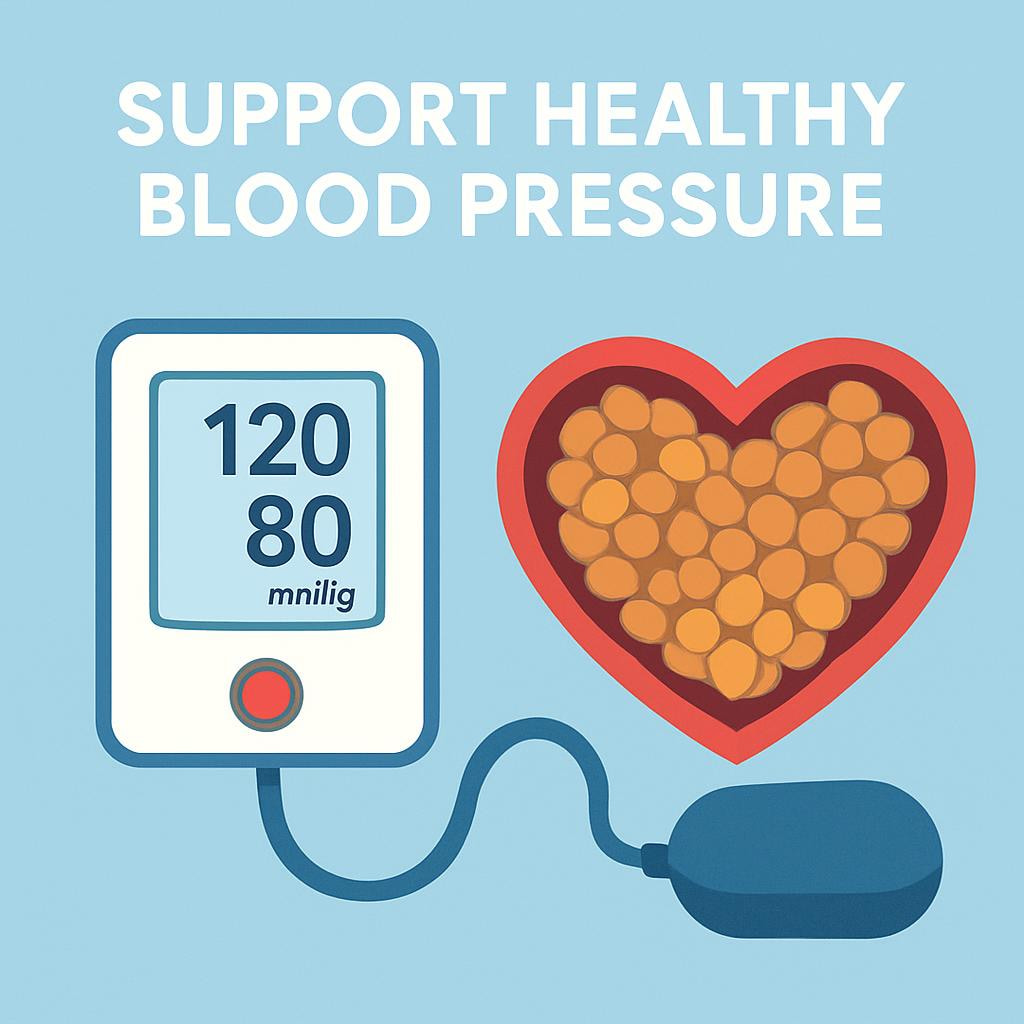
The combination of fiber, magnesium, and potassium in lentils helps regulate vascular tone and fluid balance — key for maintaining normal blood pressure.
A clinical trial published in Nutrients (2023) observed that substituting processed foods with lentil-based meals improved systolic blood pressure after 12 weeks.
The American Heart Association recognizes legumes, including lentils, as heart-friendly foods that contribute to sodium reduction and arterial flexibility when consumed regularly.
9. Promotes Bone and Muscle Health
Lentils are naturally rich in magnesium, phosphorus, and zinc, minerals that work together to maintain bone density and muscle strength.
Their plant protein supports muscle repair and growth, particularly in vegetarian or aging populations who may have lower protein intake.
According to Harvard Health Publishing, consistent intake of magnesium- and protein-rich foods like lentils may help support skeletal health and reduce age-related muscle decline when combined with regular physical activity and calcium-vitamin D sufficiency.
10. Environmentally Sustainable and Budget-Friendly Nutrition
Lentils aren’t just healthy for people — they’re good for the planet.
The Food and Agriculture Organization (FAO) reports that lentils require significantly less water and fertilizer than animal protein sources and improve soil fertility through nitrogen fixation.
This makes lentils an environmentally sustainable protein option that supports global food security while remaining cost-effective and accessible.
Including lentils in your diet promotes both personal wellness and ecological balance.
How to Eat Lentils for Maximum Benefits
Lentils are simple to prepare and highly adaptable to various cuisines — but cooking and portion practices influence how well your body digests and absorbs their nutrients.
1. Recommended Serving Size
For most healthy adults, ½ to 1 cup of cooked lentils per day (about 100–200 g) is a beneficial and balanced amount.
This portion provides roughly 18 g of protein, 15 g of fiber, and an array of essential vitamins and minerals that support overall wellness.
2. Safe Cooking Methods
Proper cooking ensures lentils are safe to eat, easier to digest, and retain their valuable nutrients. Following evidence-based preparation methods helps preserve folate and neutralize naturally occurring compounds that can affect digestion.
- Rinse thoroughly: Wash lentils under running water to remove dirt, dust, or debris that may have accumulated during storage or packaging.
- Soak before cooking: Soaking for 2–4 hours (especially green or brown lentils) helps reduce cooking time, enhances texture, and improves digestibility by lowering levels of phytates and oligosaccharides.
- Cook in fresh water: Use clean, unsalted water and simmer lentils for 15–30 minutes, depending on the variety. Avoid adding salt or acidic ingredients (like tomatoes or vinegar) at the start, as these can toughen the lentil’s skin.
- Avoid overcooking: Excess heat and long cooking times can degrade heat-sensitive nutrients, particularly folate (vitamin B9).
- Ensure food safety: Proper cooking destroys potential natural toxins and bacteria. According to the U.S. Food and Drug Administration (FDA), legumes should be cooked thoroughly to inactivate naturally occurring compounds such as lectins, which can cause digestive discomfort if consumed raw or undercooked.
By following these safe cooking practices, you preserve both the nutritional quality and safety of lentils — making them an excellent addition to a balanced, health-supportive diet.
3. Sprouting for Enhanced Nutrition
Sprouting lentils for 2–3 days increases the availability of iron, zinc, and vitamin C while reducing phytate content (a compound that can limit mineral absorption).
Sprouted lentils can be used raw in salads or lightly steamed for safety.
4. Combine with Grains for Complete Protein
Lentils lack two essential amino acids (methionine and cysteine). Pairing them with grains like rice, quinoa, or whole wheat provides a complete protein, ideal for vegetarian and vegan diets.
The Harvard T.H. Chan School of Public Health recommends combining plant protein sources to ensure full amino acid coverage.
5. Healthy Ways to Include Lentils
- Add to soups, stews, and curries for rich texture and protein.
- Toss green or black lentils into salads for fiber and minerals.
- Blend into veggie patties or dips for a plant-based protein boost.
- Mix red lentils into smoothies or baby food for mild flavor and easy digestion.
Tip: Add vitamin C–rich foods (tomatoes, citrus, bell peppers) to meals to improve iron absorption.
Note: Offering portion guidance and safety preparation ensures accurate, actionable nutrition advice consistent with food safety standards.
Possible Side Effects and Precautions
Lentils are a safe and nutrient-rich food for most people, but as with any high-fiber legume, moderation and proper preparation are key to comfortable and balanced digestion.
Because lentils are high in fiber and resistant starch, a sudden increase in intake may cause temporary gas, bloating, or digestive discomfort. These effects are harmless and typically improve as the digestive system adjusts. To reduce symptoms, rinse lentils thoroughly, soak them before cooking, and increase your intake gradually over several days.
Lentils also contain phytates—naturally occurring compounds that can slightly reduce the absorption of minerals such as iron and zinc. While this effect is minimal in a varied diet, pairing lentils with vitamin C–rich foods (like tomatoes, bell peppers, or citrus fruits) or sprouting them before cooking can help improve mineral absorption and nutrient availability.
Allergic reactions to lentils are uncommon but may occur in individuals with sensitivities to other legumes such as chickpeas, soy, or peanuts. Symptoms can include mild itching, swelling, or digestive upset. Anyone who experiences allergic symptoms should stop consuming lentils and seek medical evaluation.
Because lentils are naturally high in potassium (about 730 mg per cooked cup), people with chronic kidney disease or those following a potassium-restricted diet should consult a healthcare professional before increasing consumption. Additionally, canned lentils can contain added salt or preservatives that raise sodium levels; choosing low-sodium or no-salt-added varieties and rinsing them before use can help maintain heart-healthy sodium levels.
According to the U.S. National Library of Medicine’s MedlinePlus, properly cooked legumes like lentils are safe for most individuals and can form part of a heart-healthy, balanced diet. However, people with digestive or kidney conditions should tailor their intake based on professional medical guidance.
Recommended Daily Intake and Storage Tips
1. Daily Intake Guidelines
- Adults: ½–1 cup cooked lentils (100–200 g) daily.
- Children (4–13 years): ¼–½ cup cooked lentils daily for fiber and protein support.
- Pregnant Women: 1 cup cooked lentils daily to meet increased folate and iron needs (consult healthcare provider).
- Elderly Adults: ½ cup daily to support protein maintenance and digestion.
These quantities are consistent with the Dietary Guidelines for Americans (2020–2025), which recommend legumes several times per week for balanced nutrition.
2. Storage and Food Safety
Dry Lentils
- Store in airtight containers in a cool, dry place below 25 °C (77 °F).
- Keep away from direct sunlight or moisture; shelf life up to 12 months.
Cooked Lentils
- Refrigerate promptly in sealed containers and consume within 3–5 days.
- Reheat thoroughly before serving (to 165 °F / 74 °C).
- For longer storage, freeze cooked portions for up to 3 months.
These recommendations align with FDA Food Safety Guidelines and USDA storage standards for prepared foods.
Frequently Asked Questions (FAQ)
1. Are lentils good for heart health?
Yes. Lentils are rich in fiber, potassium, and polyphenols that support cholesterol and blood pressure balance. Cleveland Clinic
2. Can lentils help manage blood sugar?
Yes. Lentils have a low glycemic index and help stabilize blood glucose levels when eaten with balanced meals. Harvard Nutrition Source
3. Are lentils safe during pregnancy?
Absolutely. Lentils are excellent sources of folate and iron, which support fetal development and maternal health. NIH Office of Dietary Supplements
4. Do lentils cause bloating?
Only temporarily if you’re not used to high-fiber foods. Soaking, rinsing, and gradual introduction minimize discomfort.
5. Can people with kidney disease eat lentils?
Those with advanced kidney disease should monitor potassium intake. Always follow a doctor or dietitian’s advice.
6. Are canned lentils as healthy as dried?
Yes, but rinse them before use to reduce sodium and preservatives.
7. Can I eat lentils daily?
Yes. Moderate daily intake (½–1 cup cooked) provides steady fiber and protein without excess calories.
Conclusion
Lentils are among the most affordable, nutrient-rich, and sustainable foods available.
Regular consumption may help support heart and digestive health, stable blood sugar, muscle maintenance, and nutrient adequacy, especially in plant-based diets.
Their versatility — from soups and curries to salads and spreads — makes them easy to include in everyday meals. When paired with grains, lentils provide a complete amino acid profile, supporting long-term wellness and sustainable eating habits.
Always consume lentils as part of a balanced, diverse diet and consult a healthcare professional for personalized nutrition guidance.
This content is for informational purposes only and not medical advice.
References
- U.S. National Library of Medicine – MedlinePlus: “Beans and Gas”
https://medlineplus.gov/ency/patientinstructions/000726.htm - U.S. Food and Drug Administration (FDA) – “Natural Toxins in Food”
https://www.fda.gov/food/chemical-contaminants-pesticides/natural-toxins-food - U.S. Department of Agriculture (USDA) – FoodData Central: Lentils, Cooked
https://fdc.nal.usda.gov/fdc-app.html#/food-details/174684/nutrients - Harvard T.H. Chan School of Public Health – “Legumes (Beans, Peas, and Lentils)”
https://www.hsph.harvard.edu/nutritionsource/legumes-beans-peas-and-lentils/ - Cleveland Clinic – “Health Benefits of Lentils”
https://health.clevelandclinic.org/health-benefits-of-lentils
